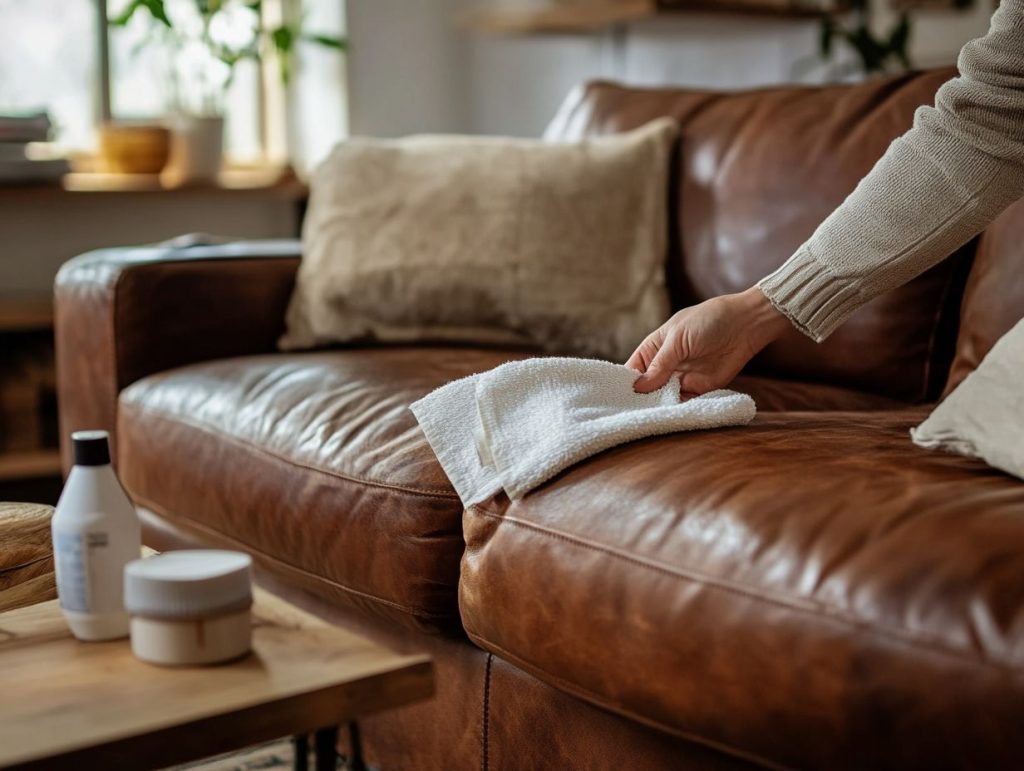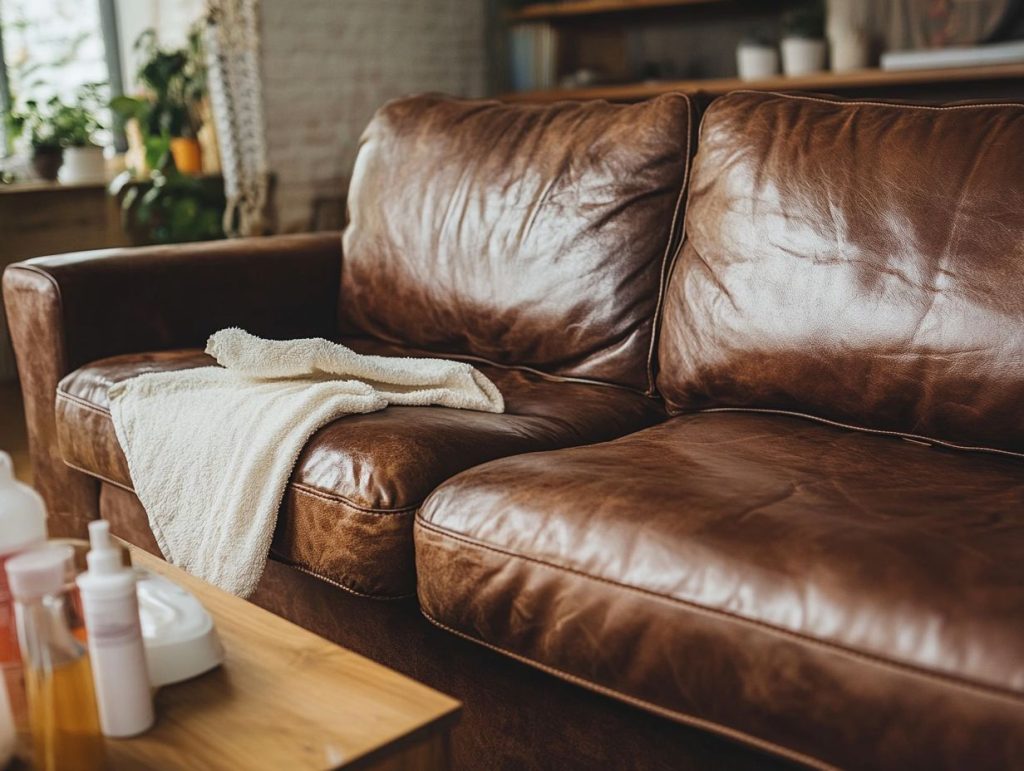How to Clean and Maintain Leather Furniture in the Living Room
I can’t imagine my living room without my large, comfy leather sofa, but it requires the proper care to keep it looking its best. We are talking about stain removal, maintenance hacks, and prevention tips – because we all know prevention is much better than reaction.
This guide covers basic cleaning techniques, effective stain removal methods, and the importance of conditioning to protect your investment. With the right approach, your leather furniture can remain a stunning centrepiece in your home for years.

Why Proper Cleaning and Maintenance is So Important
Taking care of your leather furniture is crucial—not just for how it looks but also for how long it lasts. Using the proper leather care techniques, you can keep your pieces looking sharp and ensure they remain the star of your living room décor.
First things first: know your leather. Different types—such as aniline, pigmented, or semi-aniline—require different cleaning and conditioning methods. A little bit of knowledge goes a long way!
Incorporating regular cleaning habits, such as gently dusting and using the right leather cleaners, enhances the appearance and texture of your furniture. Proper care practices make your furniture more resistant to wear and tear, maintaining that luxurious feel and stunning look. Furthermore, regular maintenance extends the lifespan of your leather pieces and increases their overall value, making them a fantastic investment for your home.
Types of Leather Furniture
Understanding the different types of leather furniture is key to taking good care of it. Whether you have leather sofas, modular, or chairs, each type has its own unique texture and characteristics that will influence how you should maintain it.
The leather upholstery in your living room can really impact the space’s appearance and function, so you will want to use the right cleaning and maintenance techniques that cater to its specific needs.
Differences in Care and Maintenance
The differences in care and maintenance for various types of leather can be quite significant. Properly maintaining your leather ensures it remains beautiful and functional over time. For example, while some leather types appreciate a regular dose of conditioner, others might require more specialised treatments to keep their finish and texture intact.
Take smooth leather, for instance. It usually needs a gentle wipe with a damp cloth and a spritz of high-quality protective spray to guard against stains. On the other hand, nubuck or suede requires a dedicated brush to lift dirt and a specialised eraser to tackle those pesky marks.
Different leathers also have varying moisture retention levels, which affect how often you should condition them—smoother varieties typically benefit from conditioning every three to six months, while more textured types might need it less frequently. Understanding these little details in leather care keeps your items looking sharp and helps them last longer.

Basic Cleaning Techniques for Leather Furniture
Adopting basic cleaning techniques for your leather furniture is key to keeping it looking great and lasting longer. Regular cleaning helps maintain that rich texture you love and prevents dust and spills from piling up.
With a few simple cleaning tips and the right tools and products, you can ensure your leather upholstery remains in excellent condition while enhancing the overall appearance of your furniture.
Step-by-Step Instructions
Following step-by-step instructions for cleaning your leather goods makes the process a doddle and delivers fantastic results. Start by gathering your cleaning supplies, including a microfiber cloth and gentle cleaners specifically made for leather care. This organised approach helps you tackle every part of the cleaning process, from dusting off the leather surfaces to applying leather conditioner like a professional.
Next, consider using a specialised leather cleaner that won’t strip away precious natural oils from the material. Avoid harsh chemicals; they can really ruin the finish.
- To kick things off, lightly dust the leather with a dry microfiber cloth to remove any surface dirt.
- Then, dampen another cloth with the cleaner and gently wipe the surface in circular motions. Don’t forget to pay extra attention to the areas that get the most use, like armrests or bag handles.
- After cleaning, always follow up with a leather conditioner to keep things supple and prevent cracking.
By regularly sticking to these best practices, your leather goods can retain their charm and last a long time.
Dealing with Stains and Spills
Dealing with stains and spills on leather can feel overwhelming, but you’ve got this! The key is to act quickly to prevent any permanent damage.
Using effective stain removal techniques, you can keep your leather furniture looking smart. Whether you’re relying on home remedies or opting for specialised cleaning solutions, knowing how to handle different types of stains will definitely make the whole process a lot smoother.
Specific Stain Removal Methods
Specific stain removal methods can vary depending on the type of stain and the leather finish, so it is crucial to know the right approach. For example, some stains might need a professional touch, while others can be tackled right at home using leather repair techniques and specialised cleaning products for leather surfaces. Knowing how to clean leather cushions and handle odours can help your furniture last longer.
For pesky stains like ink or grease, you might want to try a mix of distilled water and white vinegar. Just apply it gently with a soft cloth or grab a commercial leather cleaner formulated for tough marks.
Bicarbonate of soda is your best friend when it comes to odours. Sprinkle it on the affected area, let it sit overnight, and then vacuum it up.
And do not forget about prevention! Protective sprays designed for leather can create a barrier against future stains and spills, keeping the beauty and integrity of your leather items intact for years to come.
Conditioning and Protecting Leather Furniture
Conditioning and protecting your leather furniture is essential to keep it soft and prevent damage over time. By regularly applying a quality leather conditioner, you’re nourishing the leather and giving it a nice boost in appearance with that protective layer.
Sticking to a consistent leather furniture care routine will help ensure your leather seating stays looking and feeling its best for years.
Products and Techniques for Long-Term Maintenance
Selecting the right products and techniques for long-term maintenance can extend the lifespan of your leather furniture. Using quality leather care products and following some handy maintenance tips, you can keep your clean leather looking sharp and protected from wear and tear. Taking proactive steps to protect your furniture is key to preserving the quality and beauty of your leather upholstery for years.
Regular cleaning routines and conditioning treatments boost the aesthetic appeal and prevent the leather from drying out and cracking. It’s a good idea to seek out specialised cleaners that are gentle yet effective and specifically designed for leather surfaces.
Remember to dust your furniture regularly and use a soft cloth to eliminate dirt and prevent build-up. Investing in leather protectants can act as a barrier against spills and stains, helping to keep the material in top shape. These methods will ensure your furniture looks fantastic and maintains its luxurious feel throughout its lifespan.

